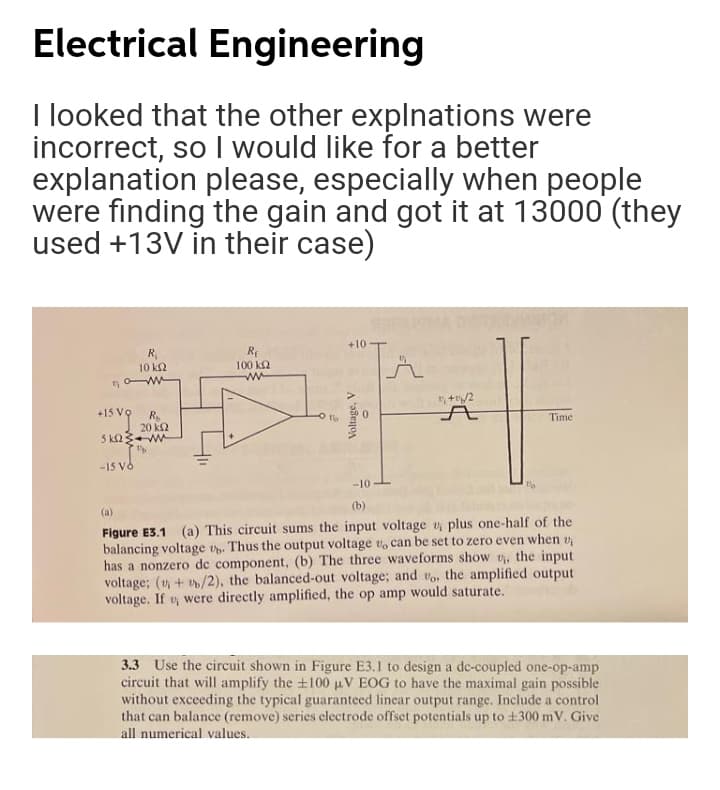(a) This circuit sums the input voltage y plus one-half of the oltage t. Thus the output voltage t, can be set to zero even when v ero de component, (b) The three waveforms show t, the input + /2), the balanced-out voltage; and to, the amplified output were directly amplified, the op amp would saturate.
(a) This circuit sums the input voltage y plus one-half of the oltage t. Thus the output voltage t, can be set to zero even when v ero de component, (b) The three waveforms show t, the input + /2), the balanced-out voltage; and to, the amplified output were directly amplified, the op amp would saturate.
Introductory Circuit Analysis (13th Edition)
13th Edition
ISBN:9780133923605
Author:Robert L. Boylestad
Publisher:Robert L. Boylestad
Chapter1: Introduction
Section: Chapter Questions
Problem 1P: Visit your local library (at school or home) and describe the extent to which it provides literature...
Related questions
Question

Transcribed Image Text:Electrical Engineering
I looked that the other explnations were
incorrect, so I would like for a better
explanation please, especially when people
were finding the gain and got it at 13000 (they
used +13V in their case)
+10
R,
10 k2
Rp
100 k2
+15 Vo
Time
20 k2
5 k23W
-15 Vô
-10
(b)
(a)
Figure E3.1 (a) This circuit sums the input voltage v plus one-half of the
balancing voltage v. Thus the output voltage v, can be set to zero even when v
has a nonzero de component, (b) The three waveforms show v, the input
voltage; (v + v/2), the balanced-out voltage; and vo, the amplified output
voltage. If vy were directly amplified, the op amp would saturate.
3.3 Use the circuit shown in Figure E3.1 to design a de-coupled one-op-amp
circuit that will amplify the +100 uV EOG to have the maximal gain possible
without exceeding the typical guaranteed linear output range. Include a control
that can balance (remove) series clectrode offset potentials up to +300 m V. Give
all numerical values.
Voltage, V
Expert Solution
This question has been solved!
Explore an expertly crafted, step-by-step solution for a thorough understanding of key concepts.
This is a popular solution!
Trending now
This is a popular solution!
Step by step
Solved in 2 steps with 1 images

Knowledge Booster
Learn more about
Need a deep-dive on the concept behind this application? Look no further. Learn more about this topic, electrical-engineering and related others by exploring similar questions and additional content below.Recommended textbooks for you

Introductory Circuit Analysis (13th Edition)
Electrical Engineering
ISBN:
9780133923605
Author:
Robert L. Boylestad
Publisher:
PEARSON

Delmar's Standard Textbook Of Electricity
Electrical Engineering
ISBN:
9781337900348
Author:
Stephen L. Herman
Publisher:
Cengage Learning

Programmable Logic Controllers
Electrical Engineering
ISBN:
9780073373843
Author:
Frank D. Petruzella
Publisher:
McGraw-Hill Education

Introductory Circuit Analysis (13th Edition)
Electrical Engineering
ISBN:
9780133923605
Author:
Robert L. Boylestad
Publisher:
PEARSON

Delmar's Standard Textbook Of Electricity
Electrical Engineering
ISBN:
9781337900348
Author:
Stephen L. Herman
Publisher:
Cengage Learning

Programmable Logic Controllers
Electrical Engineering
ISBN:
9780073373843
Author:
Frank D. Petruzella
Publisher:
McGraw-Hill Education

Fundamentals of Electric Circuits
Electrical Engineering
ISBN:
9780078028229
Author:
Charles K Alexander, Matthew Sadiku
Publisher:
McGraw-Hill Education

Electric Circuits. (11th Edition)
Electrical Engineering
ISBN:
9780134746968
Author:
James W. Nilsson, Susan Riedel
Publisher:
PEARSON

Engineering Electromagnetics
Electrical Engineering
ISBN:
9780078028151
Author:
Hayt, William H. (william Hart), Jr, BUCK, John A.
Publisher:
Mcgraw-hill Education,